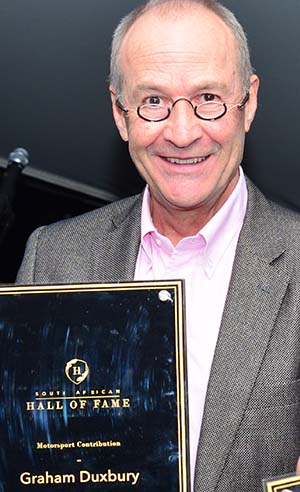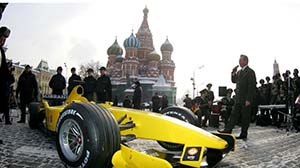In the midst of the austerity mandated by Covid-19, Formula One fans will most likely be denied the convention of new-season car launches.
 By Graham Duxbury
By Graham Duxbury
In fact, since the sport’s almost-forgotten days of excess, the unveiling of the latest racers has been down-played. Nowadays, many of these supposedly-auspicious events quietly take place in the pitlane.
By contrast, F1 followers might remember the glitz and glamour associated with past launches such as McLaren’s unveiling of its MP4/12 at the Alexandra Palace, or the reveal of Eddie Jordan’s EJ15 in Red Square (pictured).
Then there was the introduction of the Lotus 81 at a Paris nightclub which, according to a respected journalist, “was only talked about in hushed tones when no kids were around”.
In 1996, McLaren had a particularly dismal year, so in a bid to add some early excitement to the 1997 season the team decided to reveal its new car at the upmarket Alexandra Palace entertainment and sports venue in London.
No expense was spared. A trendy concert was staged with pop culture icons, the Spice Girls, on hand to perform. They were supported by Grammy award-winning Jamiroquai, the London-based funk and acid jazz band.
For McLaren, the voguish unveiling seemed to add some impetus to the start of 1997. At the season’s opener in Melbourne, David Coulthard gave the team its first win for almost four years. He would win only once more with the MP4/12, at the Italian Grand Prix, while teammate Mika Häkkinen book-ended the year with a win at the season-ending European GP at Jerez.
The launch must have made an impression on Gerri Halliwell (Ginger Spice). She became an avid motorsport fan and is today married to Red Bull Racing’s team principal Christian Horner.
New F1 cars have been revealed in all manner of striking locations over the years, including the Piazza San Marco in Venice (Benneton), the Teatro Massimo opera house in Sicily (Renault) and the spectacular Gateway of India in Mumbai (Force India).
Back in 2005, the Jordan team opted to launch their latest racer in Moscow’s historic Red Square.
In freezing winter weather, to the strident sounds of a local military band, Eddie Jordan’s bright yellow EJ15 was wheeled out to meet the press and be photographed against the backdrop of such landmarks as the Kremlin, Lenin’s Mausoleum and the ornately-domed Cathedral of Saint Basil.
Following the photo-op and interviews with drivers Tiago Monteiro and Narain Karthikeyan (the first Indian national to race in F1), a “glitzy party” was held, according to reports.
 The choice of the venue was based on commercial dictates. It was because Alex Shnaider, the Russian-born Canadian businessman, had recently bought the Jordan team which would later become known as Midland. It’s the same Silverstone-based team that in 2021 will carry Aston Martin branding.
The choice of the venue was based on commercial dictates. It was because Alex Shnaider, the Russian-born Canadian businessman, had recently bought the Jordan team which would later become known as Midland. It’s the same Silverstone-based team that in 2021 will carry Aston Martin branding.
Jordan did not live up to its launch “hype”. The team struggled in 2005 with its lone highlight being Monteiro’s third-place finish at the infamous US GP at Indianapolis in which only six cars competed.
The Lotus 81 launch at the Paradis Latin Nightclub in Paris in December 1979 set new standards for resplendence. Funded by new Team Lotus sponsor, Essex Petroleum, with caviar and champagne flowing, it was suggested that the lavish event appealed more to the bon viveur than the F1 devotee.
Essex was a Monaco-based company owned by David Thieme who was credited with “bringing glamour and extravagance to motorsport”. He ensured that the Lotus 81 was surrounded by flocks of scantily-clad showgirls as it was lowered from the nightclub’s ceiling looking impressive in its silver, red and blue Essex livery.
Naturally, blaring rock music, dense smoke and showers of glitter accompanied the slick presentation. World champion Mario Andretti was at the wheel of the slowly-descending car looking a little nonplussed, it was noted.
Regrettably, the opulence of the exotic cocktail-fuelled launch party, said to have cost $60 000, or around $215 000 in today’s money, was not matched by success on the race track. The overweight Lotus 81, based on the design of the outdated Lotus 79, was described as “singularly unexciting” and was never a race winner.
In an unfortunate sequel, Thieme was arrested in 1981 amid accusations of fraud. After investigation he was released on bail. Subsequently, Thieme disappeared and the Essex empire collapsed.
